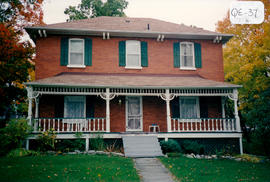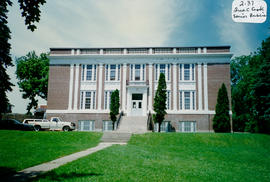The Fred C. Cook Senior Elementary School is located at 75 Queen Street. It is not the original building to be found on this site. That structure was a small, two-room, grammar school from Bond Head that was loaded onto a sled and pulled by horses many years ago to the newly-formed town of Bradford. It was set among the pine trees found on a plot of land between Fletcher and Queen Streets. That structure eventually became the first high school in Bradford. It was destroyed by fire in 1890 and a new school was opened on the same site. It burned as well. The Fred C. Cook Senior Elementary School (as seen in the photo) was erected in its place in 1923 or 1924. It was built in the Colonial Revival style. A four-room wing was built in the rear school yard in 1956 (1960’s?) to alleviate over-crowding.
The main building has 2½ storeys. Its large, simple, rectangular form dominates this site. The structure is set well back from the street on a broad expanse of lawn. This positioning suggests its importance in the community. There are large window openings with high floor to ceiling heights, and a flat roof (probably covered with built-up tar and gravel). The entrance is raised one-half storey above grade level. Stairs lead directly to an over-scaled entrance door framed by white-painted pilasters and a plain, wood entablature above. The double door and transom do not appear to be original. The tall, ‘Venetian” windows (characteristic of the neoclassical style) have pilasters and three-foot ‘lights’. The first and second-storey windows are joined by recessed, wood panels. A white-painted, urn-trimmed, roof balustrade is set into a brick, parapet wall. Thin pilaster strips (set into a continuous ‘sill’ at the ground-floor level) sub-divide the front façade into multiple bays. The building has concrete, masonry construction with brick, masonry cladding, applied wood details, and a concrete foundation. According to the 2000 inventory, the building is in excellent condition with many original details.
A new, modern version of the Fred C. Cook Elementary School opened in September, 2013. It is located at 20 Fletcher Street. (1, 3, Bradford District High School’s web site)




